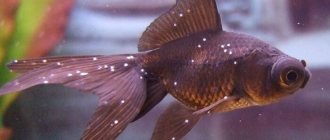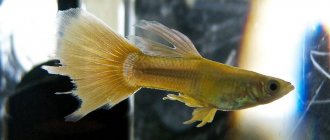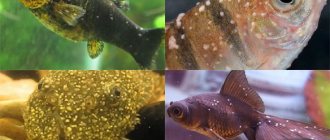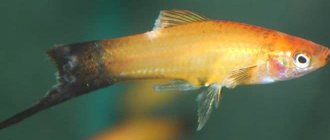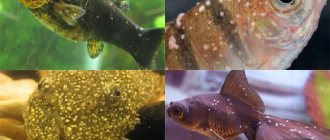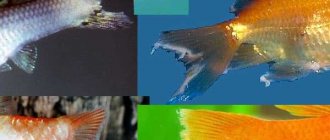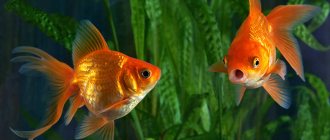The aquarium fish begins to behave strangely, becomes more lethargic, and white dots appear all over the body - these are all signs of a dangerous disease that threatens not only the health of the sick one, but also the rest of the fish in the aquarium. We are talking about a disease such as ichthyophthyriosis or “semolina” . The disease is dangerous, but completely curable if everything is done promptly and correctly. More details about the treatment of ichthyophthyriosis in aquarium fish will be discussed in this article.
Ichthyophthiriasis (semolina) in aquarium fish
Description of ichthyophthyriosis
Having penetrated into a closed environment, the disease quickly spreads among all inhabitants of the aquarium. The pest cells primarily invade the epithelium, where they feed on the skin tissue. Internal damage to the body is necessarily reflected externally, and it is not difficult to notice these changes at curable stages.
The causative agent of the disease
The cause of semolina is ichthyophthirius (lat. Ichthyophthirius multifiliis). This is a ciliate with a size of only 0.5-1 mm and a round shape. On the outside, the parasite is covered with many cilia for movement, among them there is a microscopic mouth opening. Inside the cell there are two nuclei: a large horseshoe-shaped one and a small one, as well as contractile vacuoles and dark inclusions - the food of ciliates.
It is impossible to see the ciliate with the naked eye, so it easily penetrates into new water spaces, manages to take root and reproduce before more noticeable symptoms of its presence appear. During this time, fish semolina goes through several stages of development.
Life cycle of ichthyophthirius
Despite the fact that the pathogen is a protozoan, its life cycle is polymorphic and consists of four stages:
- The cell - theront - floats freely and finds its victim, where it penetrates under the scales, into the gills, the cornea of the eyes, and fins.
- The form becomes encysted and becomes overgrown with a protective shell. At this stage, the parasite actively feeds on tissues, developing over time into a trophont. Then external symptoms appear on the fish itself.
- Maturation of the cell - trophozoite - and release into the external environment. Adult ichthyophthirius settles to the bottom.
- The trophozoite secretes a cyst. Daughter cells are formed in it - from 500 to 1000 tomits, or “vagrants”, which over time go in search of the next source of food. Their sizes are 30-50 microns.
Symptoms
Symptoms of ichthyophthirius in the body appear from the first days of the presence of the parasite. Its development is manifested in a number of behavioral and external changes in the fish, which become more and more noticeable over time.
Behavior
2-3 days after the defeat, the fish becomes more restless. It constantly rubs against the surface, soil, vegetation. If there is aeration in the aquarium, the pet will increasingly swim towards the bubbles. This is how the fish reacts to the itching caused by ichthyophthirius under the epithelium or in the gill filaments.
Barbus in the aquarium. Gold fish. Bubbles. Swirl.
External signs
When the parasitic cells gain strength and grow, very noticeable convex white dots appear on the fish’s cover. If the owner misses the ichthik, then soon all the scales will be covered with “semolina”, the fins will begin to collapse, and the fish itself will stick to the surface and swallow air. The critical stage is characterized by large ulcers growing from spots and blindness. Fish in this state can hardly be cured - they die. This usually occurs after two weeks without action being taken.
Appetite
Any health problems affect the fish's appetite. Ichthyophthiriasis is no exception: at first the individual consumes much less than the usual norm, then completely refuses food. The exact cause of such changes can only be established in conjunction with other symptoms.
Causes
The causative agent of semolina in fish lives not only in aquariums, but also in ordinary fresh water bodies. In this regard, it can penetrate into a clean environment in two ways:
- Through live food, soil, plants that were taken from a reservoir and not treated with boiling water;
- With new individuals, mollusks, algae, as well as equipment that were previously in contact with an aquarium where the situation with ichthyophthyriasis is unfavorable;
Ciliates can end up in an aquarium at any time of the year, but most often in the spring-summer season. It is then that the protozoa reproduce in natural conditions.
Potential victims
Ich can be caught by any aquarium fish. Another question is that organisms cope with it differently. The most resistant species are all representatives of zebrafish, Siamese algae eaters, comets, shubunkins, goldfish, and low-finned guppies.
Owners of the following species should be most wary of the appearance of ichthyophthirius in the aquarium:
- Haratsinki;
- Barbs;
- Labyrinthine;
- Most catfish;
Important: often in goldfish, ichthic progresses completely differently, and instead of the usual semolina, redness appears on the body, as if due to an infection.
Ichthyophthirius also parasitizes masonry. Diseased eggs die on the third day. Viviparous fry that pick up ciliates in the mother's body die at the age of 5-7 days. Other inhabitants of the aquarium - snails, shrimp and the like - will never catch ichthyophthyriasis in fish.
Fully or partially limited products
Excluded: pork, cooking fats, refined vegetable oil, margarine, butter, duck and goose meat, offal (kidneys, brains, liver), sausages and smoked meats. Fatty fish, fish roe (contains a large amount of cholesterol), crayfish, shrimp, crabs and any canned fish, including cod liver, are prohibited.
You should not consume puff pastry and pastry products, highly extractive meat, fish, or mushroom broths. Cream, fatty cottage cheese and sour cream are not allowed in the diet. Prohibition of consumption of chocolate, full-fat ice cream, products with cream and products with palm and coconut oil. Mayonnaise and ketchup should not be used as sauces.
Limit:
- beef (1-2 times a week);
- red fish;
- egg yolks;
- potato;
- fatty cheeses;
- nuts;
- buckwheat;
- honey.
How to treat semolina?
Since ichthyophthyriasis has always been widely known, aquarists have developed a number of patterns and, based on them, recommendations for the treatment of semolina in fish. The drugs must be combined with other procedures in order to get rid of parasites for sure.
Temperature increase
Fortunately, ciliates are very susceptible to high temperatures. If the fish are tolerant of an environment of 32-34°C, then it is worth setting these indicators for 2-3 days. Adult protozoa die within 5 hours; forms resting in the ground die after a few days.
Important: treatment in a community aquarium is not as effective as in a quarantine one: it is advisable to place the fish in a new container without soil and vegetation.
Salt
Salt is a universal remedy for combating many ectoparasites and bacteria. For fish, short-term baths are arranged in a separate vessel - with a 2-4% solution of a common household substance (20-40 g per liter, respectively). The water should be the same temperature as the aquarium environment. The duration of dipping the fish is no more than 10 minutes.
Attention: salt baths are contraindicated for catfish, barbs, calamoichts, young labyrinths suffering from ichthyophthyriosis.
Experienced aquarists do not recommend stopping only at this method when dealing with ichtosis. First of all, you need to focus on the selection of medications.
Malachite green
Another popular drug in the fight against pathogenic organisms. Malachite is a greenish toxic crystal: they can often be found in liquid complex products. Their concentration varies, so you should always follow the instructions for a specific solution.
To treat ichthyophthyriosis in an aquarium, the solution is poured every 2-3 days, and the water is changed by a quarter. It is advisable to increase the aeration of the aquarium during this period. Adsorbents will help moderate the toxic effect on fish. The course continues until the white spots on the fish disappear, plus another three days for prevention.
Hydrogen peroxide
Peroxide enriches the environment with oxygen, which is an excellent basis for the recovery of fish. In order not to harm your pets, you should strictly follow the recommended dosage: a 3% solution is mixed into the quarantine aquarium - 1 ml per 10 liters.
Furacilin and furazolidone
Furacilin is sold in the form of a yellow powder. It is added to the tank in the form of a solution, taking into account 0.1 g per 50 l. Treatment of semolina in aquarium fish lasts 14 days with periodic addition of furatsilin and renewal of water in the aquarium.
Furazolidone is used in a ratio of three tablets (50 mg) per 50 liters. The medicine is added to the aquarium once a day for six days in the amount of half the initial dose - with a water change. Goes well with the malachite green preparation.
Iodine and potassium permanganate
These substances are more auxiliary than complete remedies for ichthyophthyriosis. Iodine is added to the aquarium at the rate of 5 drops per 100 liters, but it will only be effective at a temperature of no more than 28°C.
Potassium permanganate is a good disinfectant, used in a separate vessel, where 0.5 g of crystals are dissolved per 10 liters. The fish take this bath for 10-15 minutes every 12 hours. The number of procedures depends on how quickly ichthyophthyriosis is treated.
Antibiotics
A powerful and essential weapon if the fish semolina has reached a critical stage before treatment. For ichthyophthyriosis, antibiotics such as Biomitsin, Bicillin, Levorin are suitable. Each is used in accordance with the instructions.
Specialized means
Complex drugs aimed at treating semolina and other diseases of protozoal origin will cope with the problem faster and better. These include:
- Antipar. A time-tested antiparasitic and antibacterial drug, which includes blue, formaldehyde and malachite green.
- JBL Punktol ULTRA. A medicine with a high concentration of malachi.
- SERA Costapur. Copes with all forms of ectoparasites, including ichthyophthirius.
- Sera Omnisan. Suitable for treating primarily pond species.
- Tetra Medica Contralck. An excellent remedy for invasive diseases.
- JBL Punktol ULTRA. Aimed at combating ichthyoparasites.
In order not to doubt the selection of products and their dosage, you can always seek advice from a veterinarian who treats representatives of the ichthyofauna.
Table of permitted products
| Proteins, g | Fats, g | Carbohydrates, g | Calories, kcal | |
| Vegetables and greens | ||||
| eggplant | 1,2 | 0,1 | 4,5 | 24 |
| beans | 6,0 | 0,1 | 8,5 | 57 |
| zucchini | 0,6 | 0,3 | 4,6 | 24 |
| cabbage | 1,8 | 0,1 | 4,7 | 27 |
| broccoli | 3,0 | 0,4 | 5,2 | 28 |
| Brussels sprouts | 4,8 | 0,0 | 8,0 | 43 |
| cauliflower | 2,5 | 0,3 | 5,4 | 30 |
| green onion | 1,3 | 0,0 | 4,6 | 19 |
| bulb onions | 1,4 | 0,0 | 10,4 | 41 |
| carrot | 1,3 | 0,1 | 6,9 | 32 |
| cucumbers | 0,8 | 0,1 | 2,8 | 15 |
| squash | 0,6 | 0,1 | 4,3 | 19 |
| salad pepper | 1,3 | 0,0 | 5,3 | 27 |
| parsley | 3,7 | 0,4 | 7,6 | 47 |
| salad | 1,2 | 0,3 | 1,3 | 12 |
| beet | 1,5 | 0,1 | 8,8 | 40 |
| celery | 0,9 | 0,1 | 2,1 | 12 |
| soybeans | 34,9 | 17,3 | 17,3 | 381 |
| asparagus | 1,9 | 0,1 | 3,1 | 20 |
| tomatoes | 0,6 | 0,2 | 4,2 | 20 |
| Jerusalem artichoke | 2,1 | 0,1 | 12,8 | 61 |
| pumpkin | 1,3 | 0,3 | 7,7 | 28 |
| dill | 2,5 | 0,5 | 6,3 | 38 |
| beans | 7,8 | 0,5 | 21,5 | 123 |
| garlic | 6,5 | 0,5 | 29,9 | 143 |
| lentils | 24,0 | 1,5 | 42,7 | 284 |
| Fruits | ||||
| avocado | 2,0 | 20,0 | 7,4 | 208 |
| oranges | 0,9 | 0,2 | 8,1 | 36 |
| pomegranate | 0,9 | 0,0 | 13,9 | 52 |
| grapefruit | 0,7 | 0,2 | 6,5 | 29 |
| pears | 0,4 | 0,3 | 10,9 | 42 |
| lemons | 0,9 | 0,1 | 3,0 | 16 |
| mango | 0,5 | 0,3 | 11,5 | 67 |
| tangerines | 0,8 | 0,2 | 7,5 | 33 |
| nectarine | 0,9 | 0,2 | 11,8 | 48 |
| peaches | 0,9 | 0,1 | 11,3 | 46 |
| apples | 0,4 | 0,4 | 9,8 | 47 |
| Berries | ||||
| gooseberry | 0,7 | 0,2 | 12,0 | 43 |
| Red currants | 0,6 | 0,2 | 7,7 | 43 |
| black currant | 1,0 | 0,4 | 7,3 | 44 |
| Nuts and dried fruits | ||||
| nuts | 15,0 | 40,0 | 20,0 | 500 |
| almond | 18,6 | 57,7 | 16,2 | 645 |
| flax seeds | 18,3 | 42,2 | 28,9 | 534 |
| fenugreek seeds | 23,0 | 6,4 | 58,3 | 323 |
| sunflower seeds | 20,7 | 52,9 | 3,4 | 578 |
| Cereals and porridges | ||||
| buckwheat (kernel) | 12,6 | 3,3 | 62,1 | 313 |
| oat groats | 12,3 | 6,1 | 59,5 | 342 |
| cereals | 11,9 | 7,2 | 69,3 | 366 |
| wheat bran | 15,1 | 3,8 | 53,6 | 296 |
| Raw materials and seasonings | ||||
| basil | 2,5 | 0,6 | 4,3 | 27 |
| honey | 0,8 | 0,0 | 81,5 | 329 |
| Dairy | ||||
| kefir 0% | 3,0 | 0,1 | 3,8 | 30 |
| kefir 1% | 2,8 | 1,0 | 4,0 | 40 |
| Cheeses and cottage cheese | ||||
| cottage cheese 0.6% (low fat) | 18,0 | 0,6 | 1,8 | 88 |
| curd tofu | 8,1 | 4,2 | 0,6 | 73 |
| Meat products | ||||
| beef | 18,9 | 19,4 | 0,0 | 187 |
| Bird | ||||
| chicken fillet | 23,1 | 1,2 | 0,0 | 110 |
| turkey | 19,2 | 0,7 | 0,0 | 84 |
| Eggs | ||||
| eggs | 12,7 | 10,9 | 0,7 | 157 |
| Fish and seafood | ||||
| fish | 18,5 | 4,9 | 0,0 | 136 |
| seaweed | 0,8 | 5,1 | 0,0 | 49 |
| Oils and fats | ||||
| grape seed oil | 0,0 | 99,9 | 0,0 | 899 |
| linseed oil | 0,0 | 99,8 | 0,0 | 898 |
| olive oil | 0,0 | 99,8 | 0,0 | 898 |
| sunflower oil | 0,0 | 99,9 | 0,0 | 899 |
| Non-alcoholic drinks | ||||
| mineral water | 0,0 | 0,0 | 0,0 | — |
| instant chicory | 0,1 | 0,0 | 2,8 | 11 |
| green tea | 0,0 | 0,0 | 0,0 | — |
* data is per 100 g of product
What affects the effectiveness of treatment?
The key to a successful fight against ichthyophthirius is the strict use of preventive and medicinal products. In addition, the environment created in the quarantine aquarium affects the speed of recovery. It must meet the following criteria:
- The water temperature in the first few days is maintained at 32-34°C, then gradually decreases to normal. It is important that there are no sudden changes in the aquarium - they will negatively affect the well-being of the fish.
- There should be no soil, plants or other objects in the aquarium. Firstly, nascent ciliates can live in them if the object was previously in an infected aquarium. Secondly, this way you will protect the fish from injuries that it can inflict on itself while trying to get rid of the itch. It is better to calm it down by other means.
- Aeration needs to be increased these days - the fish need constant fresh oxygen.
- Minimum stress and irritants. Rest is the best medicine not only for humans, but also for other living beings. The fish should be kept in comfortable conditions until complete recovery.
Symptoms and causes of the disease
If white dots appear on the surface of the body of fish in an aquarium, this is the main symptom of the emerging disease. Initially, the spots appear in small quantities, then every day the white dots become more and more numerous. The white dots on the fish are no larger than a grain of semolina. Ichthyophthyriosis in fish is developed by the bacteria ciliates Ichthyophthirius entering the aquarium along with food, soil and water. Bacteria attach to the scales of fish. The semolina on the fish are not actually white spots, but tubercles through which the parasites come out.
Symptoms of the disease:
- restless behavior;
- fish rub their bodies against objects, plants and soil;
- when internal organs are damaged, pets become passive to external stimuli, their appetite disappears, they are often on the surface of the aquarium, swallowing air;
- when the cornea of the eye is damaged, blindness develops;
- the color of the scales and body fades;
- the scales are covered with a white coating.
Without immediate action, the inhabitants of the aquarium may die as a result of lack of oxygen and damage to the epithelium of a large area.
The most frequently affected species are viviparous individuals. This bacterium is harmless to humans.
Causes of fish infection with semolina:
- live food, it is especially difficult to remove parasites from plants brought from tropical places;
- the appearance of new fish in the aquarium;
- dirty soil;
- as a result of poor quality and irregular cleaning of the aquarium: the deposits on the walls should be cleaned, the filter should be washed;
- cold water;
- temperature changes in the aquarium;
- stress.
At the initial stage of infection, before the appearance of tubercles, Ichthyophthirius (another name for the disease) cannot be seen with the naked eye.
What to do with the aquarium?
A fish disease like semolina is very contagious, so absolutely all fish are quarantined. Even if they do not have any signs of ichthyophthyriasis, this does not mean that they did not have time to catch it: most likely, ichthyosis is at an early stage of development.
A complete restart of the main aquarium is not required. The fact is that in the absence of potential victims, ichthyophthirius die after three days. To speed up this process, the temperature in the main container, as well as in the quarantine container, is raised to 34°C.
If semolina was treated in the main aquarium, then at the end of the course it is necessary to restore balance to the aquatic environment. Tests for the chemical composition will help with this, followed by drugs to regulate it or a special biofilter. The level of aeration does not decrease, the bottom and surfaces siphon. The frequency of water changes is reduced gradually and ends when necessary.
Important: it is worth paying special attention to strengthening the fish’s immunity - with the help of dietary supplements in water or complex fortified feeds.
How do fish get infected?
Not only aquarium fish, but absolutely all fish can suffer from ichthyophthyriasis. Although most often it is the inhabitants of aquariums or small reservoirs where there is an overpopulation of fish that encounter the disease.
How do fish become infected with ichthyophthyriasis?
As practice shows, ciliates most often enter the aquarium in the following ways:
- when buying new fish and placing them in the aquarium;
- when feeding aquarium inhabitants with live food;
- when placing water, driftwood or plants from an untested reservoir in the aquarium.
Note! To avoid infection, all transplanted items must be pre-treated. We are talking not only about water or plants, but also about soil.
What does the disease look like?
Disease prevention
You can avoid an unpleasant disease by following a few simple rules:
- Before new pets are brought into the main tank, they must serve a two-week quarantine period. All this time, the fish must be monitored so as not to miss their possible health problems.
- The aquarium needs to be cleaned periodically: replacing some of the water, going over the soil with a siphon, washing the filter and cleaning the glass from the accumulated layer.
- Any decorative items, soil and plants must be treated in solutions or boiling water before decorating the tank with them.
- Constant monitoring of the condition of your fish will help you quickly detect negative changes and prevent the development of diseases in the early stages - quickly and cost-effectively.
There are many tips for eliminating semolina from aquarium fish, treatment and prevention. Some of them cause controversy among aquarists with many years of experience.
Have you encountered ichthik, and what methods have become effective for you? We will be glad if you share your personal experience in the comments!
Treatment
Ichthyosis is treated by a dermatologist. Depending on the complexity of the disease, treatment can be carried out both on an outpatient basis and in a hospital setting. A set of measures for the treatment of ichthyosis includes:
- taking vitamins of groups A, E, B, C;
- high doses of nicotinic acid;
- lipotropic drugs;
- drugs for immunostimulation;
- if the functions of individual organs are impaired, appropriate medications are prescribed;
- hormone therapy;
- medicinal baths with potassium permanganate;
- skin treatment with baby cream with vitamin A;
- ultraviolet irradiation;
- mud treatment, etc.
The causative agent of the disease
The main symptom of ichthyophthyriosis is small bumps on the skin or white pustules. Externally, these rashes are very similar to semolina, only much smaller. In fact, because of this similarity, the disease is often called “semolina.”
The causative agent of ichthyophthyriosis is the ciliate ichthyophthirius multifiliis, which belongs to the class Ciliata. It has a round or oval body, at the front end of which there is a mouth opening surrounded by cilia. The latter also run in lines over the entire surface of the body and ensure the movement of the ciliates.
The parasite reproduces by dividing outside the victim's body. Immediately after maturation, the trophonts rupture the pustule in the epithelium of the fish and come out. In the aquarium, they sink to the bottom, where they are attached to any suitable objects: stones, sand, gravel, algae. There they form a cyst, inside which the division process occurs.
Ichthyophthirius multifiliis is considered extremely prolific. When one trophont divides, 2000 daughter ciliates can appear. They destroy the cyst shell and enter the water, where they begin to move with the help of cilia in search of a host. If within several days the young parasite does not find a victim, it dies.
The cells that enter the fish are localized in the upper layer of the epithelium and gills, where they begin to grow rapidly. Having reached maturity, they leave the victim and the cycle begins anew.
The development of ciliates is influenced by the following parameters:
- The parasite develops normally only at a temperature of 25 ° C.
- With a decrease in temperature, the time for cyst formation and the time for the introduction of strays increases.
- Insufficient lighting prolongs the life of young cells.
- An increase in water temperature to 32 °C leads to death within 5 hours.
Fish that have recovered from ichthyophthyriasis acquire immunity. It is not absolute, but relative. That is, if it is re-infected, there is a high probability that the aquarium pet will survive.
The cells that enter the fish are localized in the upper layer of the epithelium and gills, where they begin to grow rapidly.
Menu (Power Mode)
The cholesterol diet menu is designed for 5 meals a day. Since you should not allow yourself to feel hungry during the day or in the evening, you are allowed to eat an apple, grapefruit, carrots or drink a fermented milk product. A sample menu for several days might look like this:
First option
| Breakfast |
|
| Lunch |
|
| Dinner |
|
| Afternoon snack |
|
| Dinner |
|
Second option
| Breakfast |
|
| Lunch |
|
| Dinner |
|
| Afternoon snack |
|
| Dinner |
|
Third option
| Breakfast |
|
| Lunch |
|
| Dinner |
|
| Afternoon snack |
|
| Dinner |
|
Below is a table of low-cholesterol foods that can be included in your diet.
| Products name | Featured | Prohibited |
| Fish | Lean sea fish (hake, blue whiting, pollock, navaga, pollock, haddock) and pike three times a week. | Salmon, mackerel, sardine, eel, mackerel, herring, oysters, caviar, shrimp, prepared fish, river fish in limited quantities. |
| Eggs | Up to 3 pieces per week. | Egg yolk. |
| Fats | Sunflower, corn, olive or soybean oils, up to 2 tablespoons per day. | Lard, margarine, palm and coconut oil, butter, animal fat. |
| Meat | Veal, rabbit, turkey, chicken, lean beef once or twice a week. The bird is allowed without skin. | Pork, fatty beef, fatty lamb, duck and goose meat, sausages, liver, kidneys, brain pates, sausages, sausages. |
| Dairy | Skim milk, low-fat kefir, yogurt, cheeses up to 20%, low-fat cottage cheese. | Full-fat cottage cheese, sour cream, cream, ice cream, curd mass, condensed milk, processed cheese. |
| Vegetables | Fresh and frozen, corn and beans. | Potatoes and potato snacks. |
| Fruits | Everything except banana and grapes, as well as dried fruits. | Sugared fruits, pistachios and peanuts, hazelnuts. |
| Cereals | Whole grain bread, brown rice, oatmeal, whole grain pasta. | White rice, semolina, limit buckwheat. |
| Bakery | Oatmeal cookies, bread rolls, dry cookies, “Fitness” cookies. | Biscuits, pastries, rolls, cakes, puff pastry products. |
| Sweets | Low-fat puddings, jellies without added sugar, fruit ice cream. | Chocolate, pastry cream, toffee, marmalade, pastille, sugar, syrups. |
| Beverages | Sugar-free juices, green tea, weak coffee, still mineral water. | Cocoa with milk, coffee with cream, alcoholic and sweet carbonated drinks. |
Treatment of the aquarium after illness
In principle, disinfection of the aquarium after ichthyophthyriasis is not required. The tank just needs to be left empty for 2 weeks, and there will be no infection left in it. In this case, you need to put carbon in the filter to purify the water from drugs.
Keep the water temperature at 28-29 degrees at this time. In this case, the cycle of ciliates will pass quickly, and, having emerged from the cyst, they will not find a host fish and will die. You can leave the snails in the aquarium - ciliates are only interested in fish.
Table of prohibited products
| Proteins, g | Fats, g | Carbohydrates, g | Calories, kcal | |
| Fruits | ||||
| bananas | 1,5 | 0,2 | 21,8 | 95 |
| Nuts and dried fruits | ||||
| raisin | 2,9 | 0,6 | 66,0 | 264 |
| Cereals and porridges | ||||
| semolina | 10,3 | 1,0 | 73,3 | 328 |
| white rice | 6,7 | 0,7 | 78,9 | 344 |
| Flour and pasta | ||||
| pasta | 10,4 | 1,1 | 69,7 | 337 |
| Bakery products | ||||
| bagels | 16,0 | 1,0 | 70,0 | 336 |
| bagels | 16,0 | 1,0 | 70,0 | 336 |
| crackers | 11,2 | 1,4 | 72,2 | 331 |
| Confectionery | ||||
| jam | 0,3 | 0,2 | 63,0 | 263 |
| jam | 0,3 | 0,1 | 56,0 | 238 |
| candies | 4,3 | 19,8 | 67,5 | 453 |
| pastry cream | 0,2 | 26,0 | 16,5 | 300 |
| Ice cream | ||||
| ice cream | 3,7 | 6,9 | 22,1 | 189 |
| Cakes | ||||
| cake | 4,4 | 23,4 | 45,2 | 407 |
| Chocolate | ||||
| chocolate | 5,4 | 35,3 | 56,5 | 544 |
| Raw materials and seasonings | ||||
| ketchup | 1,8 | 1,0 | 22,2 | 93 |
| mayonnaise | 2,4 | 67,0 | 3,9 | 627 |
| Dairy | ||||
| cream | 2,8 | 20,0 | 3,7 | 205 |
| sour cream 30% | 2,4 | 30,0 | 3,1 | 294 |
| sour cream 40% (fat) | 2,4 | 40,0 | 2,6 | 381 |
| Cheeses and cottage cheese | ||||
| cheese | 24,1 | 29,5 | 0,3 | 363 |
| cottage cheese 18% (fat) | 14,0 | 18,0 | 2,8 | 232 |
| Meat products | ||||
| pork | 16,0 | 21,6 | 0,0 | 259 |
| pork liver | 18,8 | 3,6 | 0,0 | 108 |
| pork kidneys | 13,0 | 3,1 | 0,0 | 80 |
| pork fat | 1,4 | 92,8 | 0,0 | 841 |
| salo | 2,4 | 89,0 | 0,0 | 797 |
| beef liver | 17,4 | 3,1 | 0,0 | 98 |
| beef kidneys | 12,5 | 1,8 | 0,0 | 66 |
| beef brains | 9,5 | 9,5 | 0,0 | 124 |
| mutton | 15,6 | 16,3 | 0,0 | 209 |
| Sausages | ||||
| smoked sausage | 16,2 | 44,6 | 0,0 | 466 |
| smoked sausage | 9,9 | 63,2 | 0,3 | 608 |
| sausages | 10,1 | 31,6 | 1,9 | 332 |
| sausages | 12,3 | 25,3 | 0,0 | 277 |
| Bird | ||||
| smoked chicken | 27,5 | 8,2 | 0,0 | 184 |
| duck | 16,5 | 61,2 | 0,0 | 346 |
| smoked duck | 19,0 | 28,4 | 0,0 | 337 |
| goose | 16,1 | 33,3 | 0,0 | 364 |
| Fish and seafood | ||||
| smoked fish | 26,8 | 9,9 | 0,0 | 196 |
| salted fish | 19,2 | 2,0 | 0,0 | 190 |
| Red caviar | 32,0 | 15,0 | 0,0 | 263 |
| black caviar | 28,0 | 9,7 | 0,0 | 203 |
| squid | 21,2 | 2,8 | 2,0 | 122 |
| shrimps | 22,0 | 1,0 | 0,0 | 97 |
| salmon | 19,8 | 6,3 | 0,0 | 142 |
| sturgeon | 16,4 | 10,9 | 0,0 | 163 |
| canned fish | 17,5 | 2,0 | 0,0 | 88 |
| semi-finished fish products | 12,5 | 6,7 | 14,7 | 209 |
| sardine | 20,6 | 9,6 | — | 169 |
| mackerel | 18,0 | 13,2 | 0,0 | 191 |
| cod (liver in oil) | 4,2 | 65,7 | 1,2 | 613 |
| boiled oysters | 14,0 | 3,0 | — | 95 |
| fresh oysters | 14,0 | 6,0 | 0,3 | 95 |
| Oils and fats | ||||
| butter | 0,5 | 82,5 | 0,8 | 748 |
| creamy margarine | 0,5 | 82,0 | 0,0 | 745 |
| coconut oil | 0,0 | 99,9 | 0,0 | 899 |
| palm oil | 0,0 | 99,9 | 0,0 | 899 |
| rendered beef fat | 0,0 | 99,7 | 0,0 | 897 |
| cooking fat | 0,0 | 99,7 | 0,0 | 897 |
| rendered pork fat | 0,0 | 99,6 | 0,0 | 896 |
| Non-alcoholic drinks | ||||
| cola | 0,0 | 0,0 | 10,4 | 42 |
| lemonade | 0,0 | 0,0 | 6,4 | 26 |
| Pepsi | 0,0 | 0,0 | 8,7 | 38 |
| sprite | 0,1 | 0,0 | 7,0 | 29 |
*data is per 100 g of product
Human medicines: Delagil and Furacilin
The antimalarial drug Delagil is inexpensive, you need to look for it in human pharmacies. Delagil is recommended to treat sensitive aquarium pets that cannot tolerate malachite; this is when its help is needed. It will not harm either the fish or the biological system. Dosage – 1 tablet per 30 liters. It is better to use in a shaded aquarium, as the drug is destroyed in the light. It gives good results when mixed with strong medications for ichthyophthyriasis, taken in a small (2-3 times less than recommended) concentration.
The method is good for its relative safety. Unlike strong drugs, which can often lead to the death of fish on their own, it does not harm the inhabitants. But its effectiveness in destroying ciliates is lower. Therefore, it is better to treat it in its pure form in the early stages of the disease. If the disease develops seriously, you will need the help of stronger remedies.
Treatment with furatsilin also gives excellent results, preserving the biosystem. Dosage - 1 tablet per 30-40 liters. Daily change of a quarter of the volume of water, adding medicine after two days, until complete cure.
